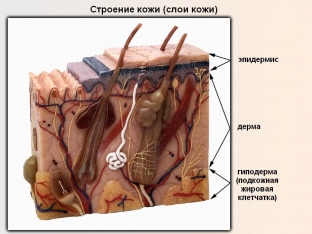Leather – it is the heaviest organ of the human body, which almost completely covers the human body. And it is the skin, as the outer covering of the body, that is most exposed to the negative effects of external environmental factors. In addition, almost all pathological conditions of the internal organs and systems of the body are reflected in the condition of the skin.
This is why modern science is so active in studying how the skin condition changes over time and how to improve it. Knowing the basics of its structure, namely the layers of the skin, is the basic foundation for every beautician.
Four layers of skin: stratum corneum, epidermis, dermis and adipose tissue
The structure of the skin is quite complex, since it is this organ that primarily performs the protective function of the body. All layers of the skin differ in their structure and the function they perform. One of the structural features of the skin is that this organ has many practically dead structures, due to which the skin lends itself well to various procedures, and its therapy often gives a good effect.
In addition, the skin is constantly renewing, so its condition can be improved with the help of cosmetic procedures. Four main layers are distinguished in the structure of the skin: horny, epidermis, dermis and subcutaneous fat.
Skin layers:
- the stratum corneum of the skin: structural features;
- epidermis – "factory" for the production of cells of the stratum corneum of the skin;
- dermis – the most important of all skin layers;
- Subcutaneous fat: why the skin needs fat.
The stratum corneum of the skin: structural features
The stratum corneum is the top layer of the skin. This layer consists of a large number of peculiar transparent scales, which are formed from keratin protein. These scales are a dead structure, since they do not have a cell nucleus, and their main function is to protect the underlying layers of the skin.
Between the scales there is an intercellular fatty substance that holds the keratin cells-scales together into a single structure. The horny layer of the skin has a water-repellent effect, preventing moisture from penetrating into the deeper layers of the skin, and vice versa, does not allow water to evaporate excessively.
Epidermis – "factory" for the production of cells of the stratum corneum of the skin
Under the stratum corneum is the epidermis. This layer of skin is a kind of "factory"; for the production of stratum corneum cells. The basal layer of the epidermis, which is located at its very bottom, consists of keratinocyte cells, the intensive division of which ensures the renewal of the skin layers. Dividing keratinocytes, as they mature, move towards the stratum corneum of the skin, replacing it over time.
Melanocytes are located between keratinocytes – pigment cells that provide the skin with one or another of its shades. In addition, Langerhans cells, which perform an immune function, and Merkel cells, which are responsible for tactile sensitivity of the skin, are found in the epidermis.
Read on the topic: "The ABC of the skin for a cosmetologist: the structure of the epidermis (part 1)"
Derma – the most important of all skin layers
Derma – this is another of the layers of the skin, located under the epidermis and basement membrane. During the analysis of the dermis under a microscope, the following structures are detected:
- collagen fibers – these protein fibers provide the skin with its elasticity and rigidity;
- elastin fibers – provide elasticity to the skin, allowing it to stretch and return to its previous state;
- hyaluronic acid – fills the space between the protein fibers of the dermis, while ensuring the retention of water in the skin;
- blood and lymph vessels – provide skin with oxygen;
- fibroblasts – the main cells of the dermis, which are located between the protein fibers and produce various connective structures.

Read on the topic: "The ABC of the skin for a cosmetologist: the structure of the dermis (part 2)"
Subcutaneous fat: why does the skin need fat
The subcutaneous fat of the skin is a very important layer of the skin, as it performs several important functions for the state of the body:
- softens the impact on the human body;
- has the ability to retain heat;
- plays an important role in the synthesis of reproductive hormones;
- gives roundness to the female form and ensures smoothness of the skin.
The adipose tissue of the skin consists of lobules, inside which lie fat cells and blood vessels, as well as fibrous tissue separating the lobules. Reducing the subcutaneous fat layer can have a very negative impact on the appearance of a person.
Read on the topic: "The ABC of the skin for a cosmetologist: The structure of the hypodermis (part 3)







Add a comment